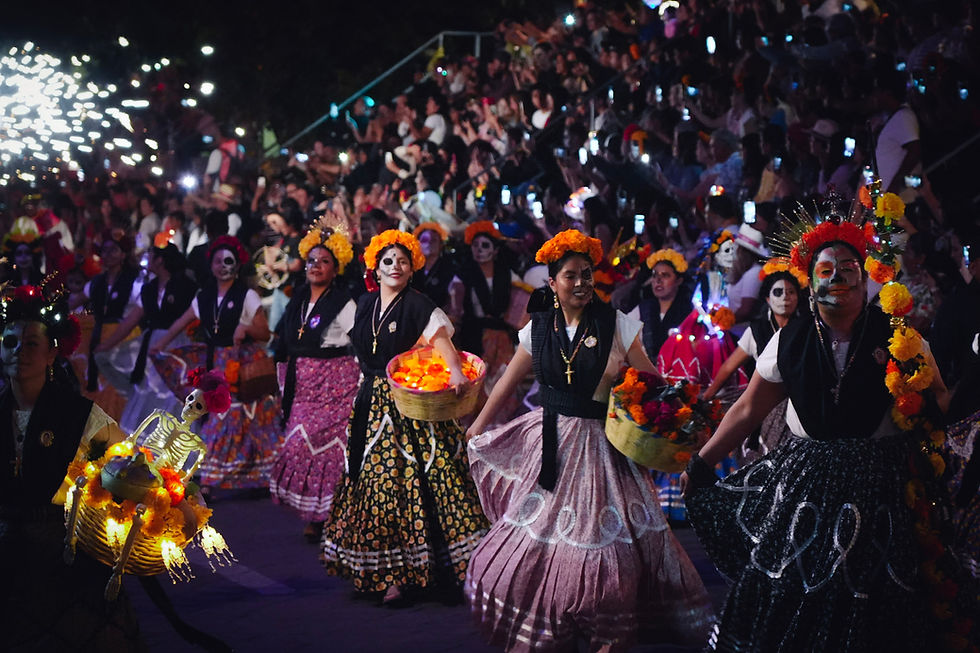DIA DE LOS MUERTOS in MEXICO | Where to Go, How It's Celebrated, When to Visit, and Fun Facts. Useful Information
- World Mappers

- Aug 8
- 5 min read
Updated: Nov 24

DAY OF THE DEAD in MEXICO
Practical information to help you organize your trip to this destination, including details on when to go, required documents, how to get around, and much more.

BRIEF HISTORY and MEANING of the DIA DE LOS MUERTOS in MEXICO
The Día de los Muertos is one of Mexico’s most deeply rooted traditions, with origins dating back to pre-Columbian cultures such as the Aztecs, who celebrated death as a natural part of life. With the arrival of the Spaniards, indigenous practices merged with Catholicism, becoming tied to All Saints’ Day and All Souls’ Day. The meaning is to honor deceased loved ones with offerings, altars, food, music, and decorations, symbolically welcoming their souls with joy rather than sadness.
WHEN TO EXPERIENCE the DIA DE LOS MUERTOS in MEXICO
Día de los Muertos is officially celebrated on November 1st and 2nd, but preparations begin in late October. October 31st is often dedicated to the souls of children, while November 1st honors deceased adults. The celebrations peak between November 1st and 2nd with public events, processions, and altars in homes and cemeteries. To fully experience the atmosphere, it is advisable to be in Mexico from around October 28–29, following the entire festive period.
WHERE TO EXPERIENCE the DIA DE LOS MUERTOS in MEXICO
Día de los Muertos is celebrated throughout Mexico, but some places offer more authentic and spectacular experiences. Oaxaca is famous for its processions, markets, and colorful altars. Mexico City hosts a large parade, partly inspired by the film Spectre. The town of Pátzcuaro, in the state of Michoacán, is renowned for its lakeside and cemetery traditions, with evocative night vigils. Mérida and the Yucatán Peninsula also feature celebrations strongly tied to Mayan culture.
HOW MUCH DOES IT COST to TRAVEL to MEXICO for the DIA DE LOS MUERTOS
Visiting Mexico during Día de los Muertos can be more expensive than other times due to the high tourist season. Flights from Europe range between €700 and €1,200, with higher prices for last-minute bookings. Hotels in major cities can cost from €50 to €200 per night. For a one-week trip, including accommodation, food, transportation, and activities, you should budget between €1,200 and €1,800 per person, depending on your travel style.
HOW the DIA DE LOS MUERTOS is CELEBRATED in MEXICO
During Día de los Muertos, Mexican families set up altars (ofrendas) in homes and cemeteries, decorated with marigolds (cempasúchil), candles, photos of the deceased, food, and personal objects. Traditional dishes such as pan de muerto are prepared, and moments of prayer and music are shared. In the streets, there are processions, performances, and parades with people dressed as calaveras (skulls) or Catrinas. It is a joyful celebration that blends religious, symbolic, and cultural elements, transforming mourning into an occasion of remembrance and celebration.

WHERE TO STAY during the DIA DE LOS MUERTOS in MEXICO
Mexico City - Gran Hotel Ciudad de México Zócalo View *****
Mexico City - Casa de la Luz Hotel Boutique *****
Mexico City - Viajero CDMX Centro Hostel **** Mexico City - Hotel Azores ***
Pátzcuaro - Mansion de los Sueños ****
Pátzcuaro - Hacienda Mariposas **** Pátzcuaro - Eco Hotel Ixhi ***
Oaxaca - Casa Mayahuel ****
Oaxaca - Hotel Guivá Aeropuerto ***
CITIES to VISIT during the DIA DE LOS MUERTOS in MEXICO

Mexico City
Mexico City, the country’s capital, is a vibrant metropolis blending history, art, and modernity. Highlights include the Zócalo, the Metropolitan Cathedral, and the National Palace. Cultural attractions abound, such as the Frida Kahlo Museum and the National Museum of Anthropology. Coyoacán preserves a bohemian atmosphere, while Xochimilco offers colorful boat rides. During Día de los Muertos, the city comes alive with large parades, public altars, and decorations in every neighborhood, making it one of the main centers of national celebration.

Oaxaca
Oaxaca is considered one of Mexico’s most fascinating cities for culture, art, and traditions. Famous for its cuisine, crafts, and colonial architecture, it features lively markets and historic squares. During Día de los Muertos, Oaxaca fills with decorated altars, sand art (colored sand carpets), and nighttime processions that involve the entire city. Families gather in cemeteries to honor their loved ones with candles, music, and food. Oaxaca is also a great starting point for visiting Monte Albán and surrounding artisan villages.
Pátzcuaro
Pátzcuaro, in the state of Michoacán, is one of the most iconic places to experience Día de los Muertos in Mexico. This small town preserves a colonial atmosphere, with cobblestone streets and white houses with red-tiled roofs. The real magic happens between November 1st and 2nd, when families decorate graves with flowers and candles, especially on the islands of Lake Pátzcuaro, such as Janitzio. At night, vigils filled with spirituality take place, with illuminated boats crossing the lake, creating a unique and deeply rooted Purépecha tradition.

TIPS for VISITING the DIA DE LOS MUERTOS in MEXICO by World Mappers
Book flights and accommodation well in advance! During Día de los Muertos, cities such as Oaxaca, Pátzcuaro, and Mexico City experience high tourist demand, with hotels and flights selling out quickly. To secure good rates and availability, it’s best to book 3–4 months ahead. This applies to both budget and luxury options. Early booking also allows you to organize tours and attend local events without missing out on the most authentic experiences.
Respect the tradition. Día de los Muertos is not Carnival but a spiritual and family-oriented commemoration. While the atmosphere is festive, it’s important to be respectful, especially in cemeteries and near private altars. Always ask permission before photographing people or ofrendas. Wearing calavera makeup is acceptable but should be done with cultural awareness. The celebration is about sharing, not trivializing a deeply rooted Mexican tradition.
Visit markets and buy traditional items. In the days leading up to Día de los Muertos, local markets fill with traditional decorations: sugar skulls, candles, marigolds, pan de muerto, and paper figurines. Visiting these markets is a must to experience the authentic atmosphere and discover unique handmade products. Buying traditional items also supports the local economy. Famous markets include those in Oaxaca, Mexico City, and the popular markets of Michoacán.
Taste the traditional foods of the celebration! Día de los Muertos is also a culinary occasion: one of its symbolic dishes is pan de muerto, a sweet bread flavored and decorated with bone-like shapes. Local bakeries and markets also sell sugar skulls, chocolate, tamales, mole, and other typical dishes. Trying these specialties is part of the experience since food holds symbolic meaning: it is offered on altars for the dead and shared among family and friends during the festivities.
Learn about the meaning before you go. Dedicating time to understand the significance of Día de los Muertos enriches the experience. You can read books, watch documentaries, or films like Coco, which make Mexican views on death more accessible. Understanding the value of memory, family, and tradition will help you appreciate the celebrations even more once there. Knowing what the altars, offerings, and symbols represent allows you to experience the trip with greater awareness and respect for local culture.

Discover More
Consult the Practical Information for your trip
Discover also:
































.jpg)













Comments